Effects of Upward Reflective Film Applied to Window Glass on Indoor and Outdoor Thermal Environments in a Mid-Latitude City
Abstract
1. Introduction
2. Calculation Methods and Measurement Conditions
2.1. Calculation of Solar Radiation and Window Surface Heat Balance and MRT
2.2. Measurement Conditions
3. Measurement and Calculation Results
3.1. Different Solar Altitude Angles and Film Properties
3.1.1. Effect of Film Properties on Different Solar Altitude Angles
3.1.2. Effect of Different Films on the Thermal Environment
3.2. Solar Radiation Balance of Windows
3.2.1. Difference in Solar Altitude Angle
3.2.2. Difference in Film Characteristics
3.3. Glass Surface Temperature, Outdoor and Indoor Mean Radiant Temperature
3.3.1. Surface Temperature of Each Window
3.3.2. Outdoor Mean Radiant Temperature
3.3.3. Indoor Mean Radiant Temperature
4. Discussion
5. Conclusions
Author Contributions
Funding
Institutional Review Board Statement
Informed Consent Statement
Data Availability Statement
Acknowledgments
Conflicts of Interest
References
- Hyunjung, L.; Helmut, M. Thermal comfort of pedestrians in an urban street canyon is affected by increasing albedo of building walls. Int. J. Biometeorol. 2018, 62, 1199–1209. [Google Scholar] [CrossRef]
- Takebayashi, H. High-reflectance technology on building façades: Installation guidelines for pedestrian comfort. Sustainability 2016, 8, 785. [Google Scholar] [CrossRef]
- Yuan, J.; Emura, K.; Farnham, C. A method to measure retro-reflectance and durability of retro-reflective materials for building outer walls. J. Build. Phys. 2014, 38, 500–516. [Google Scholar] [CrossRef]
- Yuan, J.; Farnham, C.; Emura, K. Development of a retro-reflective material as building coating and evaluation on albedo of urban canyons and building heat loads. Energy Build. 2015, 103, 107–117. [Google Scholar] [CrossRef]
- Yuan, J.; Emura, K.; Sakai, H.; Farnham, C.; Lu, S. Optical analysis of glass bead retro-reflective materials for urban heat island mitigation. Sol. Energy 2016, 132, 203–213. [Google Scholar] [CrossRef]
- Yuan, J.; Emura, K.; Farnham, C.; Sakai, H. Application of glass beads as retro-reflective façades for urban heat island mitigation: Experimental investigation and simulation analysis. Build. Environ. 2016, 105, 140–152. [Google Scholar] [CrossRef]
- Rossi, F.; Pisello, A.; Nicolini, A.; Filipponi, M.; Palombo, M. Analysis of retro-reflective surfaces for urban heat island mitigation: A new analytical model. Appl. Energy 2014, 114, 621–631. [Google Scholar] [CrossRef]
- Rossi, F.; Castellani, B.; Presciutti, A.; Morini, E.; Filipponi, M.; Nicolini, A.; Santamouris, M. Retroreflective façades for urban heat island mitigation: Experimental investigation and energy evaluations. Appl. Energy 2015, 145, 8–20. [Google Scholar] [CrossRef]
- Rossi, F.; Castellani, B.; Presciutti, A.; Morini, E.; Anderini, E.; Filipponi, M.; Nicolini, A. Experimental evaluation of urban heat island mitigation potential of retro-reflective pavement in urban canyons. Energy Build. 2016, 126, 340–352. [Google Scholar] [CrossRef]
- Castellani, B.; Morini, E.; Anderini, E.; Filipponi, M.; Rossi, F. Development and characterization of retro-reflective colored tiles for advanced building skins. Energy Build. 2017, 154, 513–522. [Google Scholar] [CrossRef]
- Ichinose, M.; Ishino, H.; Kohri, K.; Nagata, A. Calculation Method of Radiant Heat Transfer with Directional Characteristics. In Proceedings of the Technical Papers of Annual Meeting of IBPSA–Japan, Tokyo, Japan, 10–12 January 2005. [Google Scholar]
- Ichinose, M.; Inoue, T.; Nagahama, T. Effect of retro-reflecting transparent window on anthropogenic urban heat balance. Energy Build. 2017, 157, 157–165. [Google Scholar] [CrossRef]
- Nakaohkubo, K.; Hoyano, A.; Asawa, T.; Fukasawa, H. Development of outdoor heat balance simulation considering directional characteristics of reflected solar radiation from the building external surfaces. J. Environ. Eng. AIJ 2008, 625, 275–282. [Google Scholar] [CrossRef]
- Nishioka, M.; Inoue, S.; Sakai, K.; Nakao, M.; Nabeshima, M. Numerical simulation on basic properties of retroreflectors, Performance evaluation of solar retroreflectors. J. Environ. Eng. AIJ 2008, 630, 1013–1019. [Google Scholar] [CrossRef]
- Nishioka, M.; Inoue, S.; Sakai, K. Retroreflective properties calculating method based on geometrical-optics analysis, Performance evaluation of solar retroreflectors. J. Environ. Eng. AIJ 2008, 633, 1249–1254. [Google Scholar] [CrossRef]
- Yoshida, S.; Yumino, S.; Uchida, T.; Mochida, A. Effect of windows with heat ray retroreflective film on outdoor thermal environment and building cooling load. J. Heat Isl. Inst. Int. 2015, 9, 67–72. [Google Scholar]
- JIS A 1494-2021; Measurement Methods for Performance of Solar Radiation Retro-Reflectivity on Adhesive Films for Glazings. JISC: Bristol, UK, 2021.
- Harima, T.; Nagahama, T. Evaluation methods for retroreflectors and quantitative analysis of near-infrared upward reflective solar control window film—Part I: Theory and evaluation methods. Sol. Energy 2017, 148, 177–192. [Google Scholar] [CrossRef]
- Harima, T.; Nagahama, T. Evaluation methods for retroreflectors and quantitative analysis of near-infrared upward reflective solar control window film—Part II: Optical properties evaluation and verification results. Sol. Energy 2017, 148, 164–176. [Google Scholar] [CrossRef]
- The Osaka Heat Island Countermeasure Technology Consortium. Overview of the Certification System. Available online: http://www.osakahitec.com/cert/gaiyo2.pdf (accessed on 25 October 2021).
- Fox, J.; Osmond, P.; Peters, A. The Effect of Building Facades on Outdoor Microclimate—Reflectance Recovery from Terrestrial Multispectral Images Using a Robust Empirical Line Method. Climate 2018, 6, 56. [Google Scholar] [CrossRef]
- Levinson, R.; Chen, S.; Slack, J.; Goudey, H.; Harima, T.; Berdahl, P. Design, characterization, and fabrication of solar-retroreflective cool-wall materials. Sol. Energy Mater. Sol. Cells 2020, 206, 110117. [Google Scholar] [CrossRef]
- Yuan, J.; Emura, K.; Farnham, C. Evaluation of retro-reflective properties and upward to downward reflection ratio of glass bead retro-reflective material using a numerical model. Urban Clim. 2021, 36, 100774. [Google Scholar] [CrossRef]
- AGC Inc. Flat Glass Building Materials General Catalog, Technical Data Edition. Available online: https://asahiglassplaza.icata.net/iportal/CatalogDetail.do?method=initial_screen&volumeID=AGC00001&categoryID=100030000&catalogID=394950000&type=mc&position=2&sortKey=CatalogMain11590000&sortOrder=DESC&designID=AGCD001 (accessed on 25 October 2021).

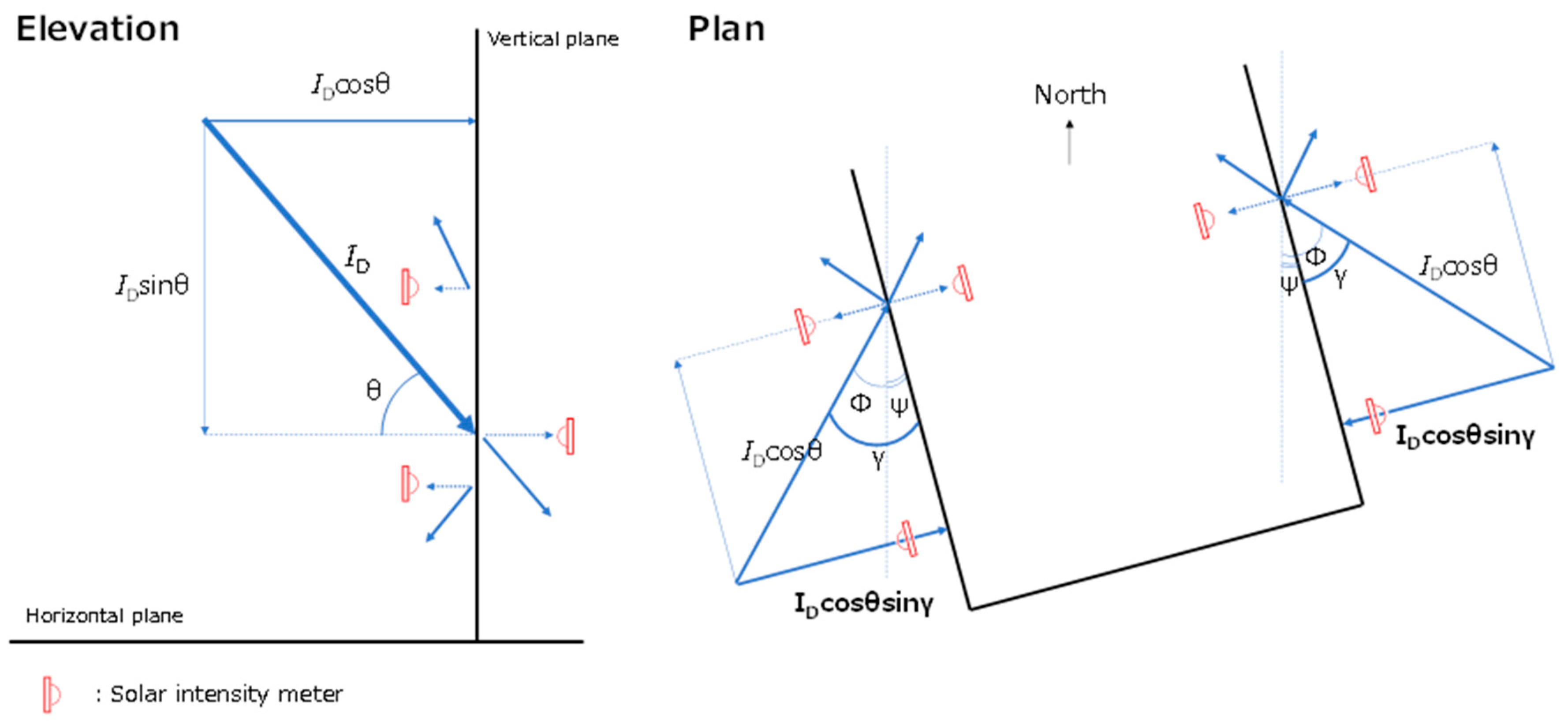
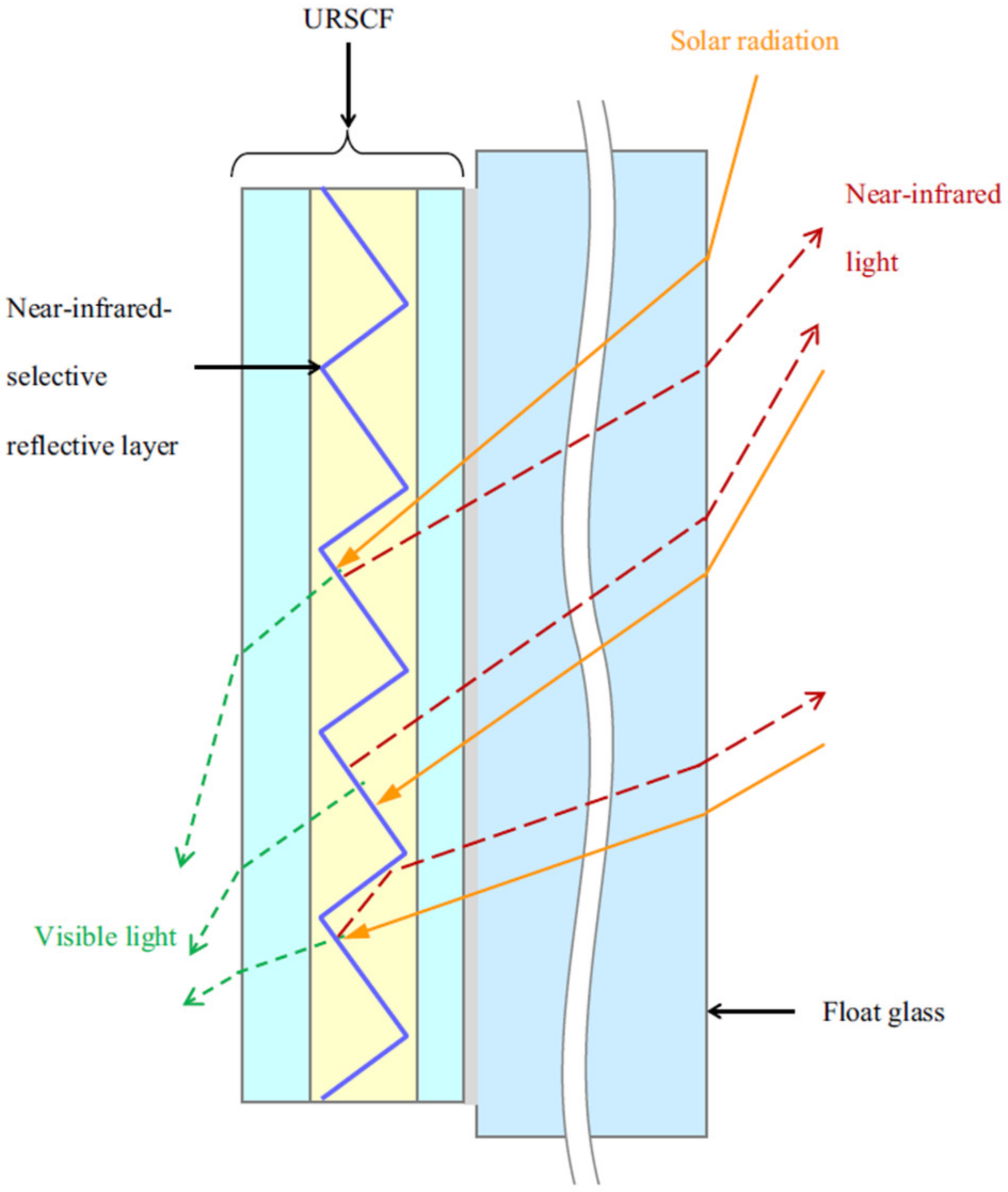

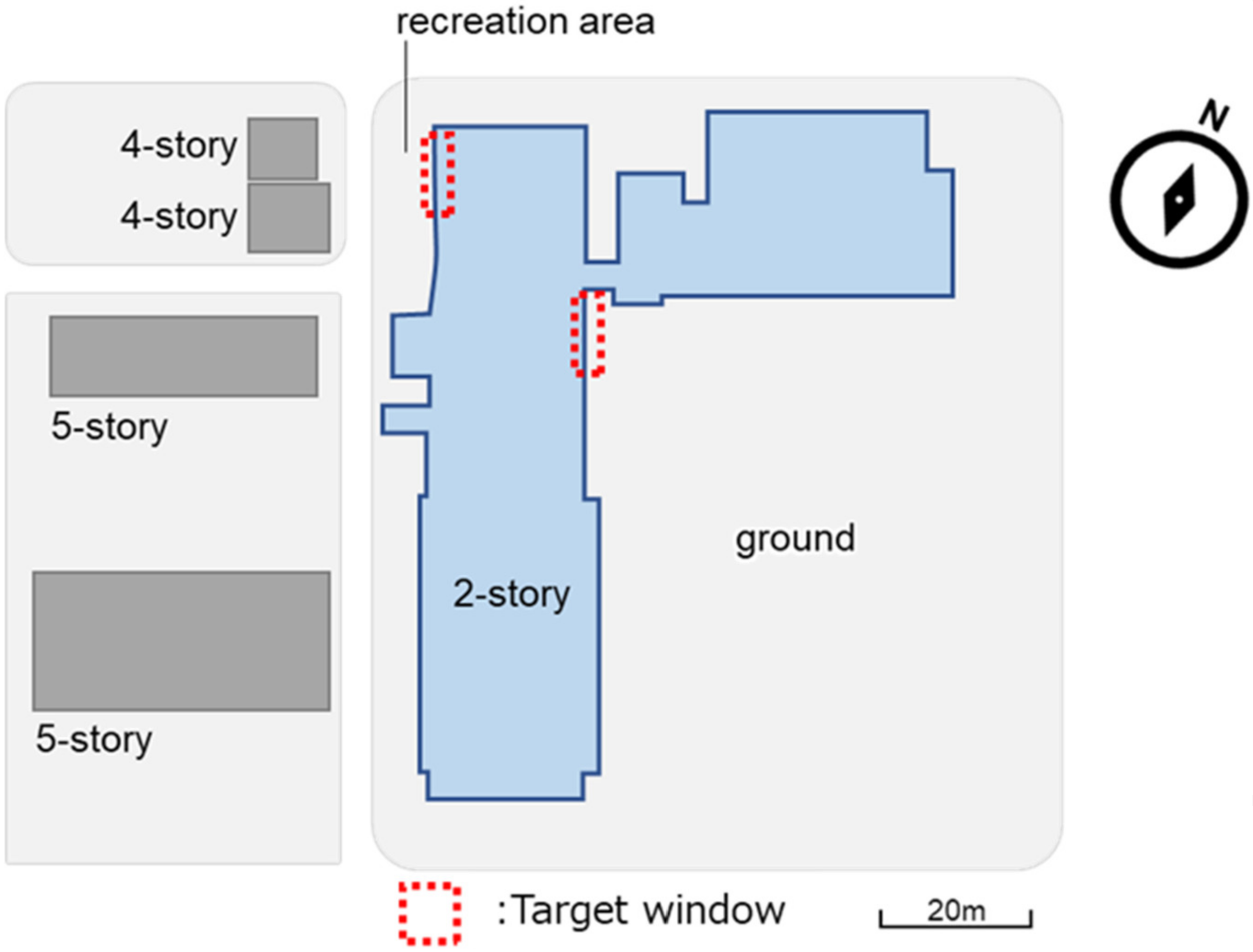


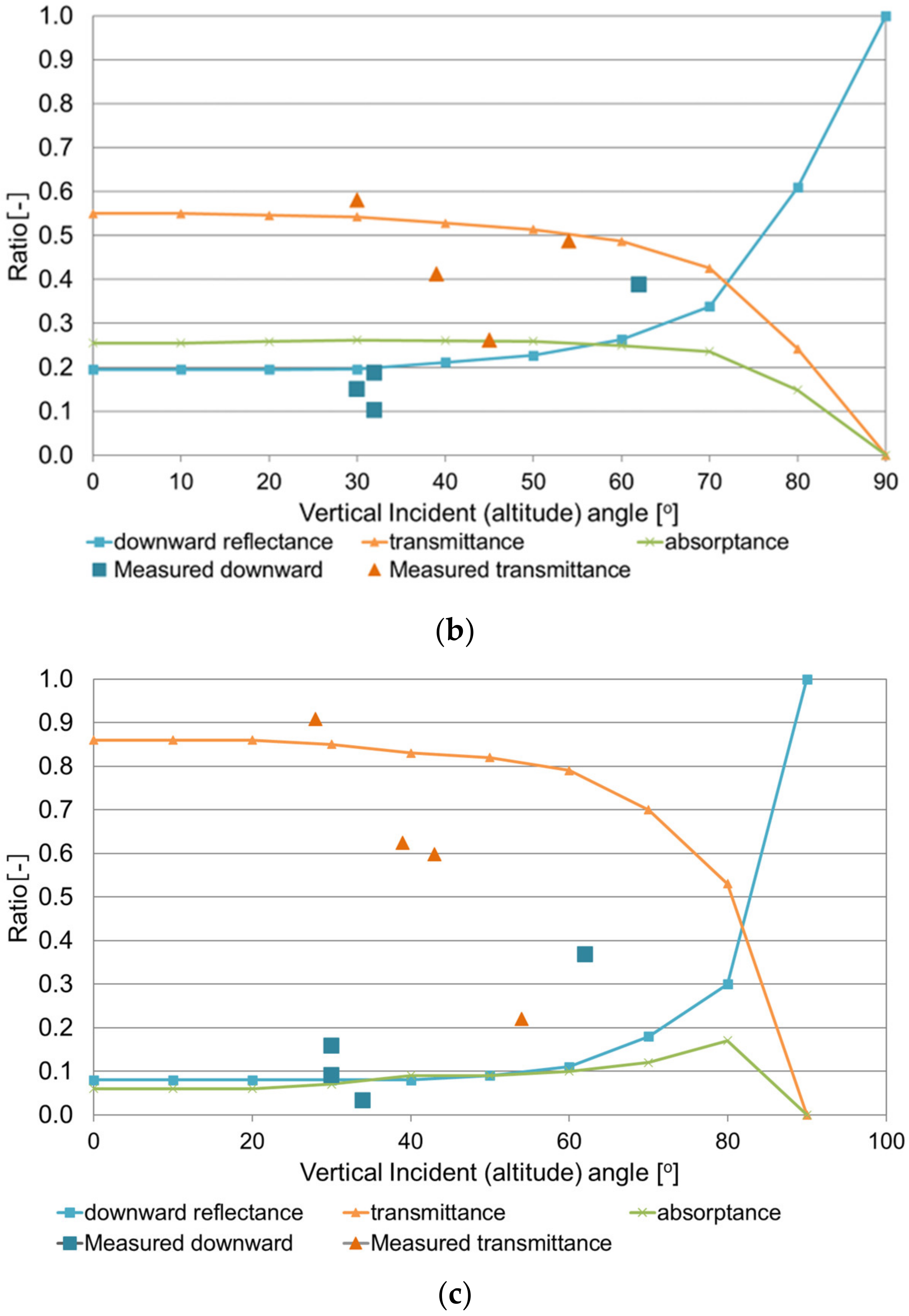
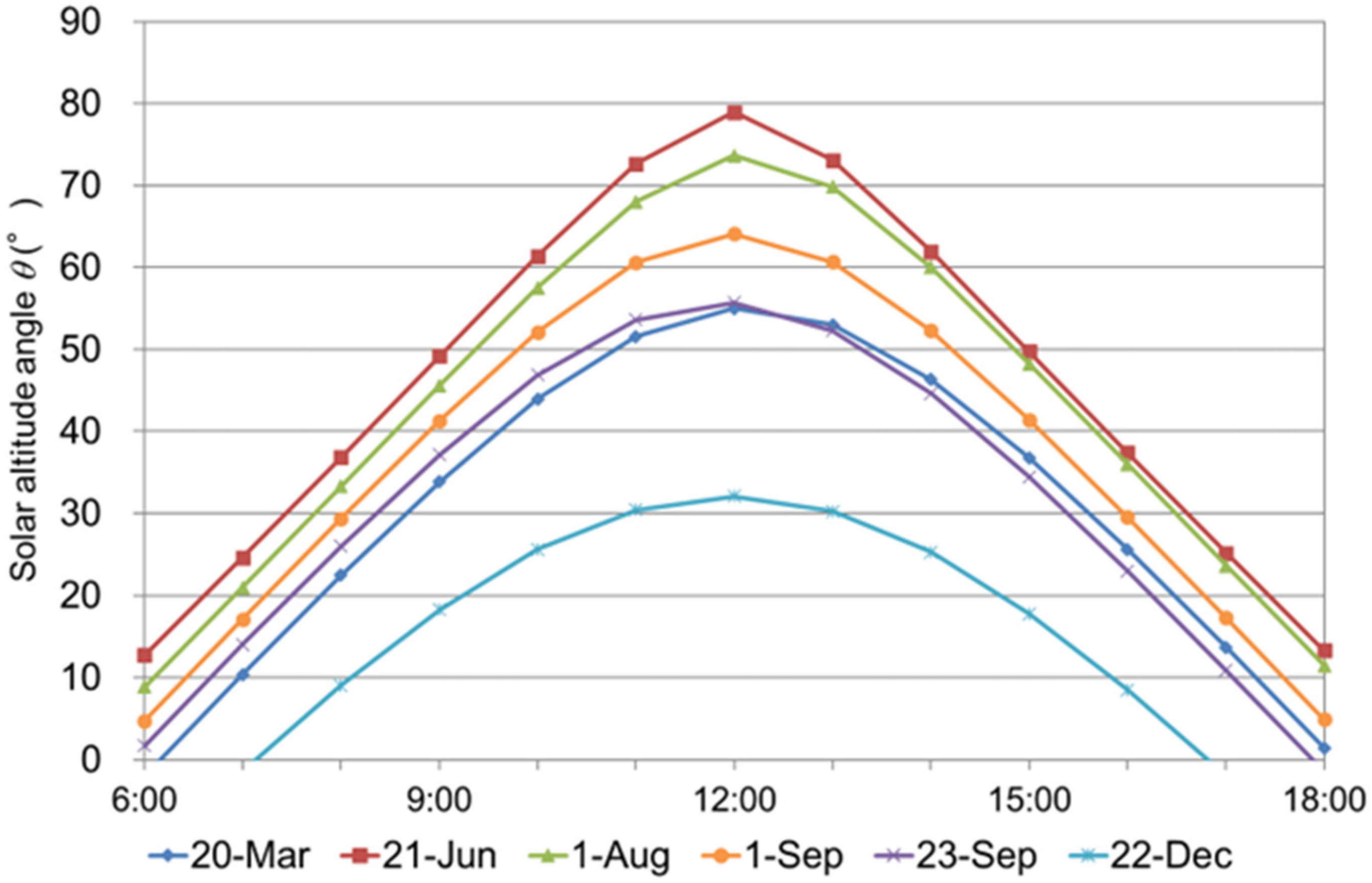

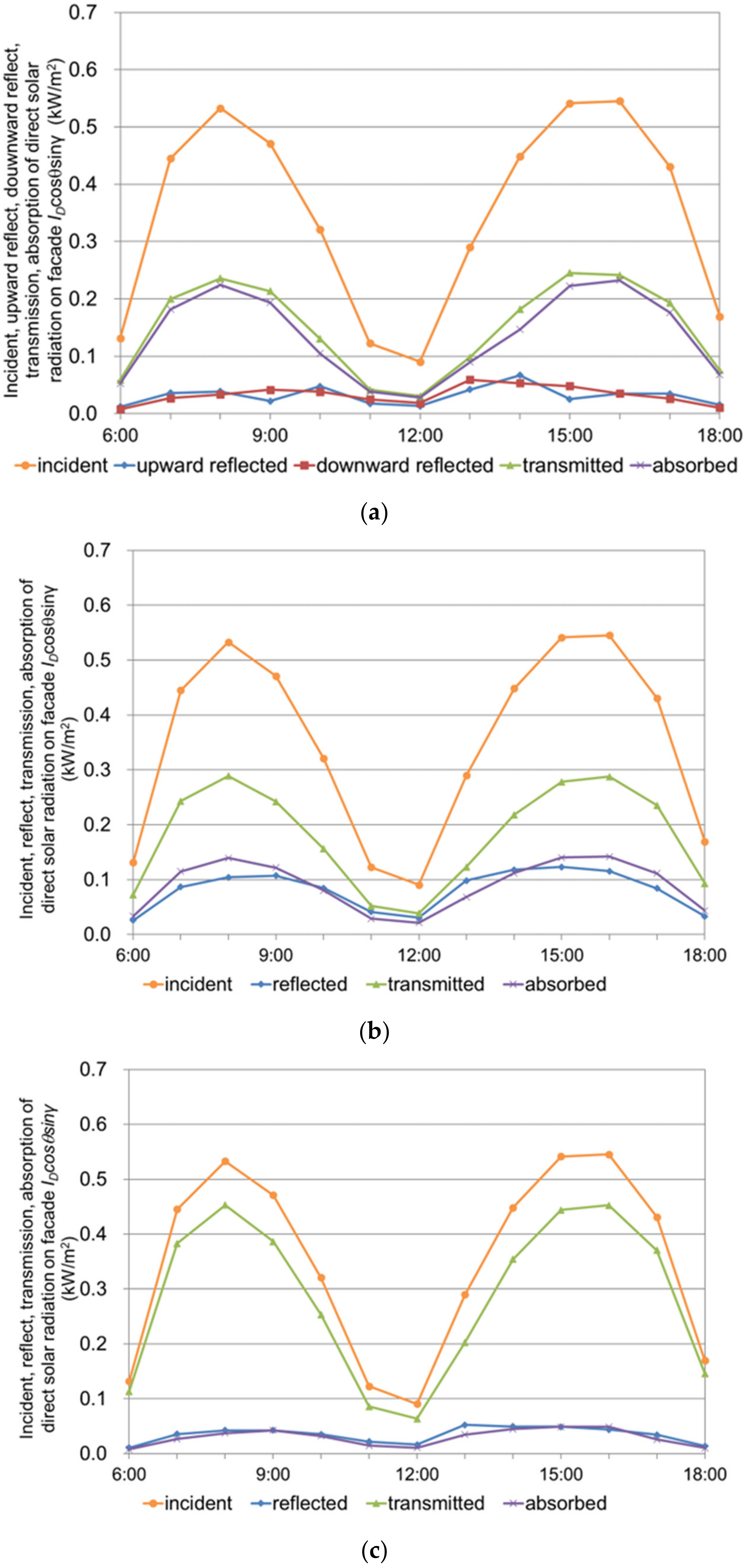
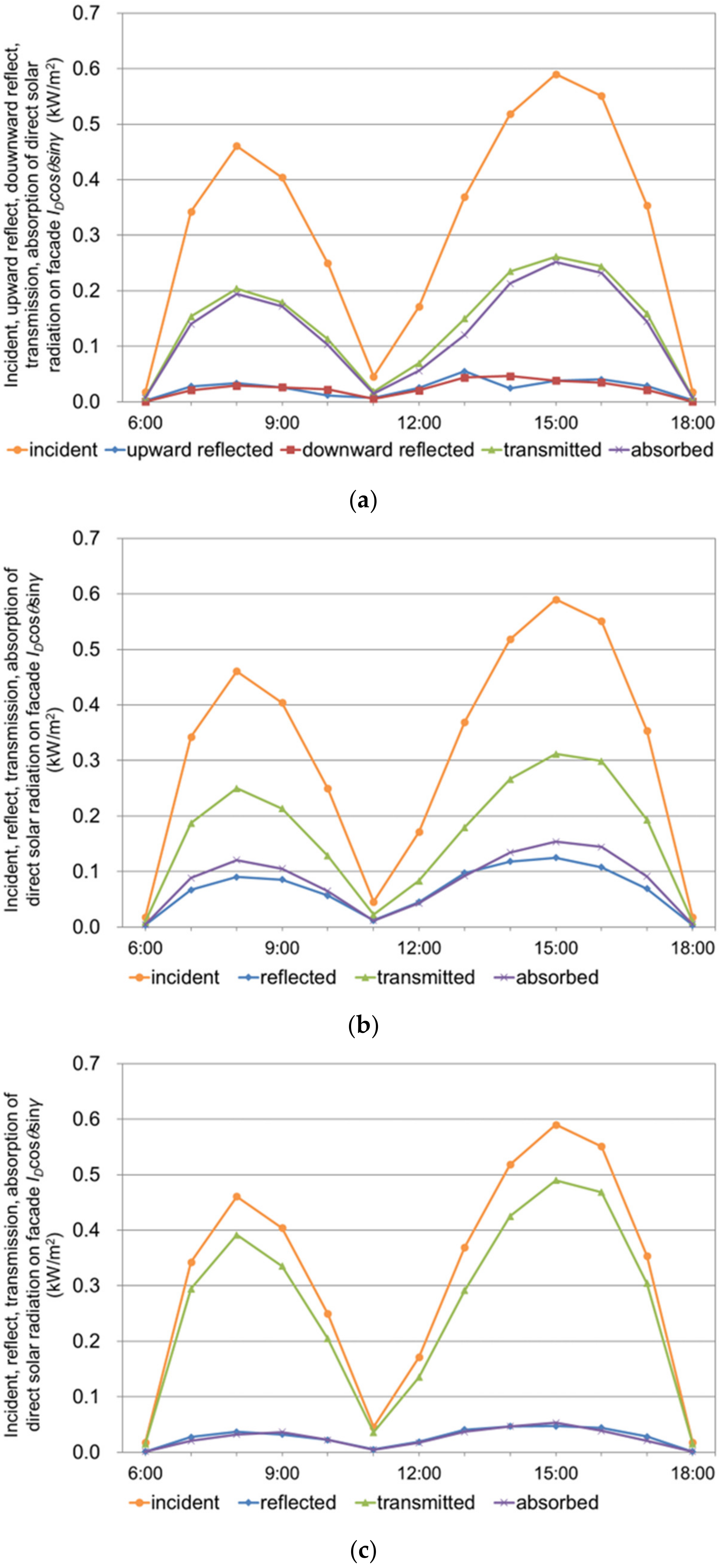
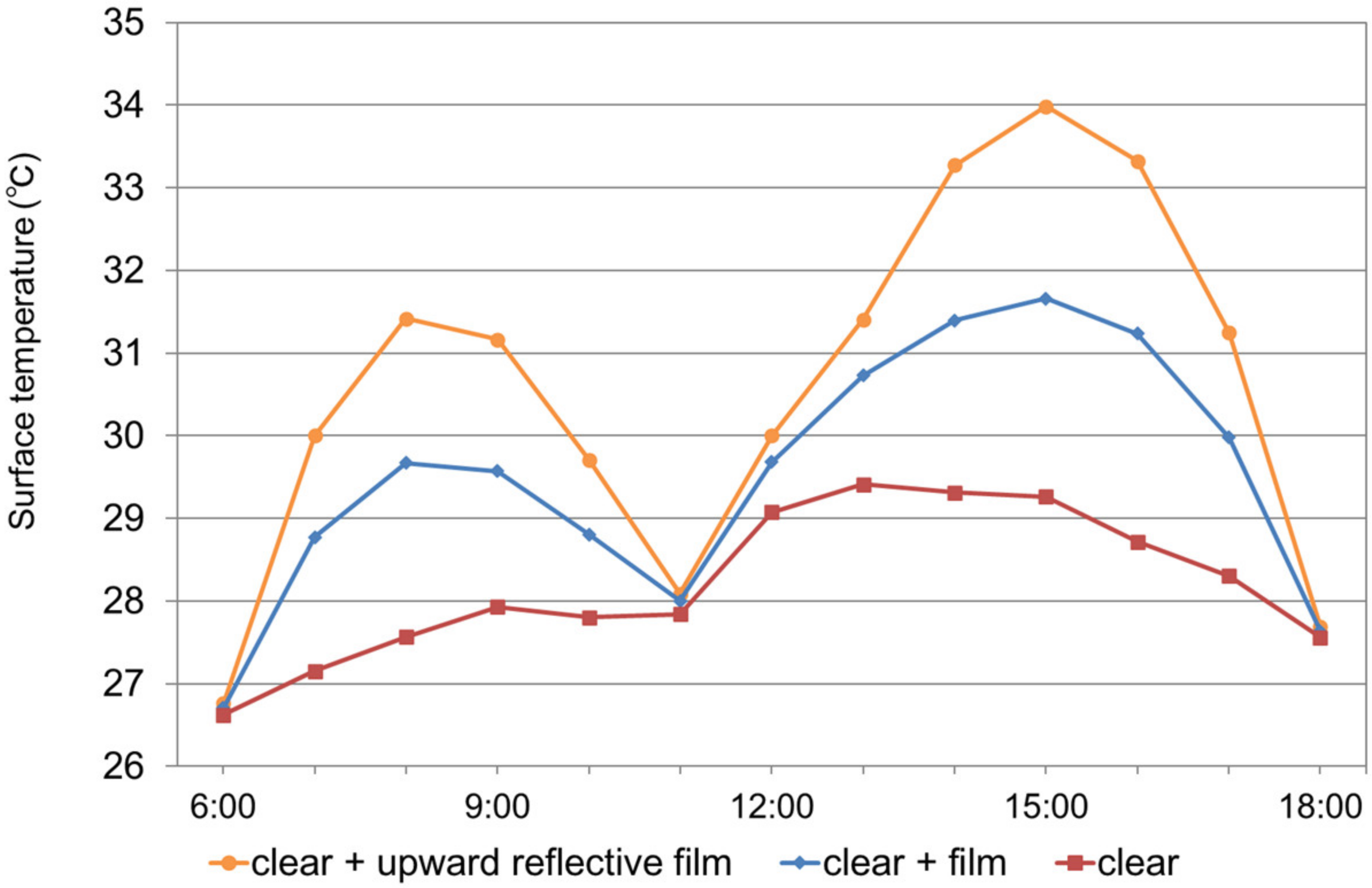




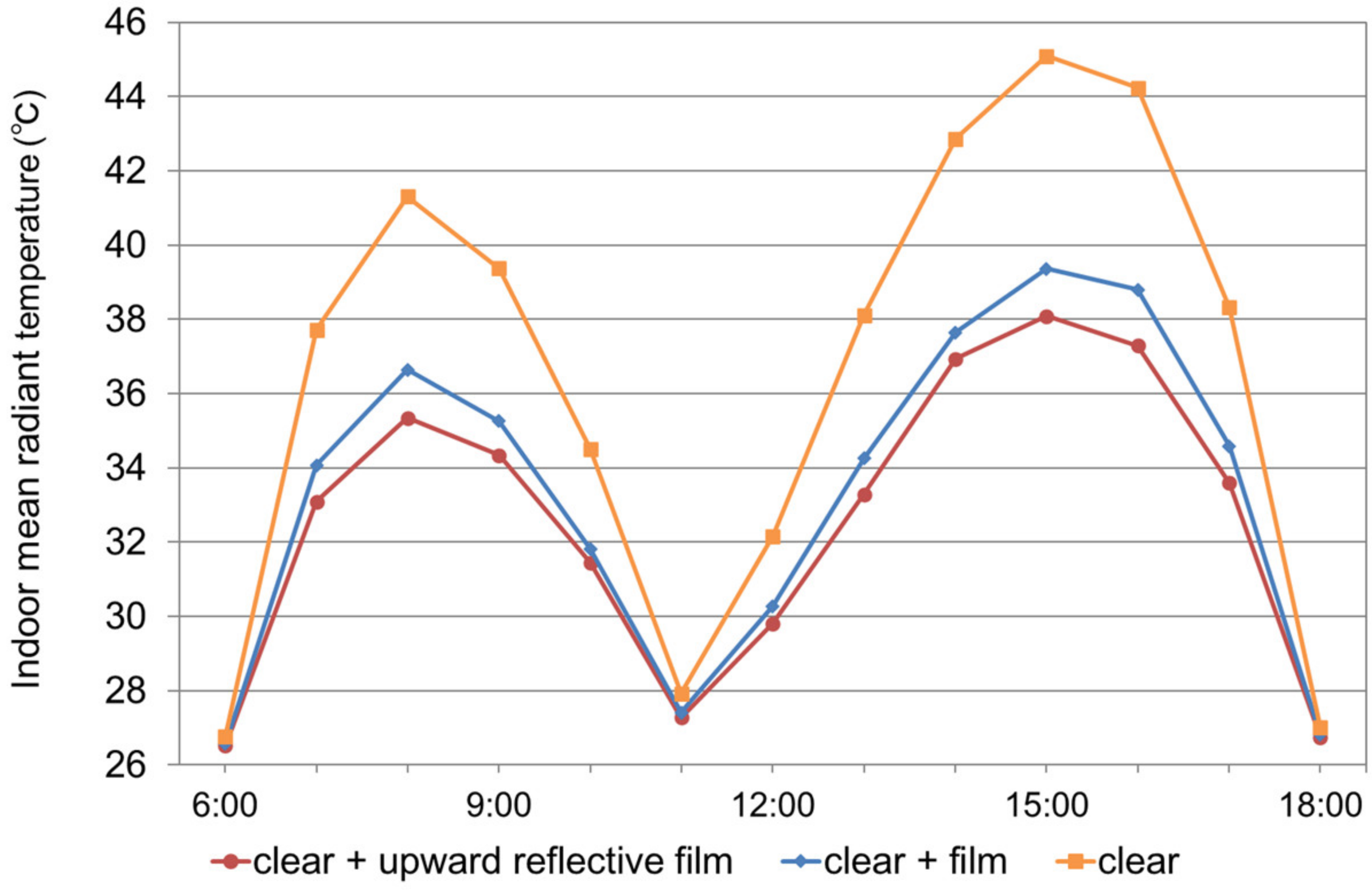

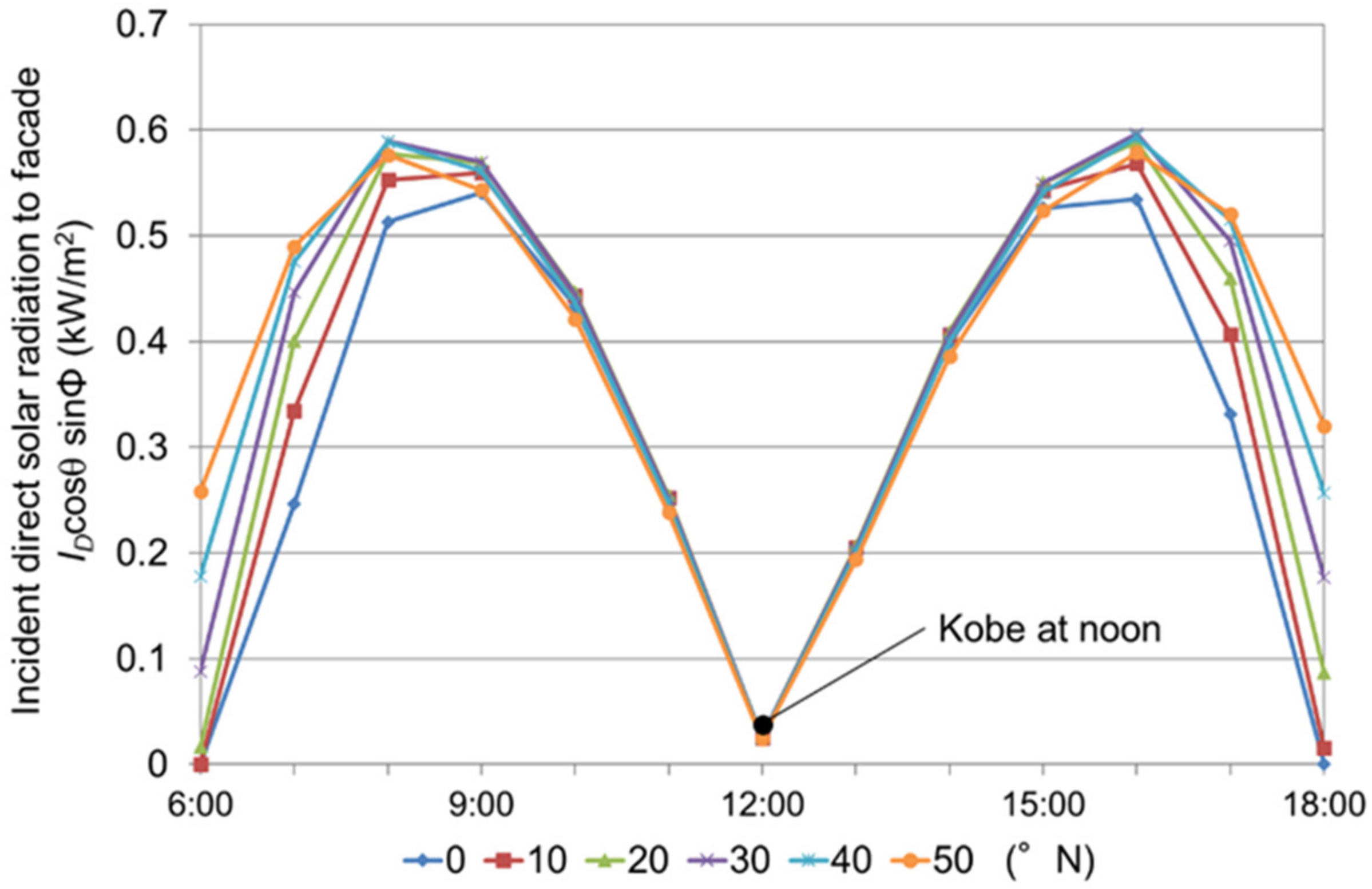
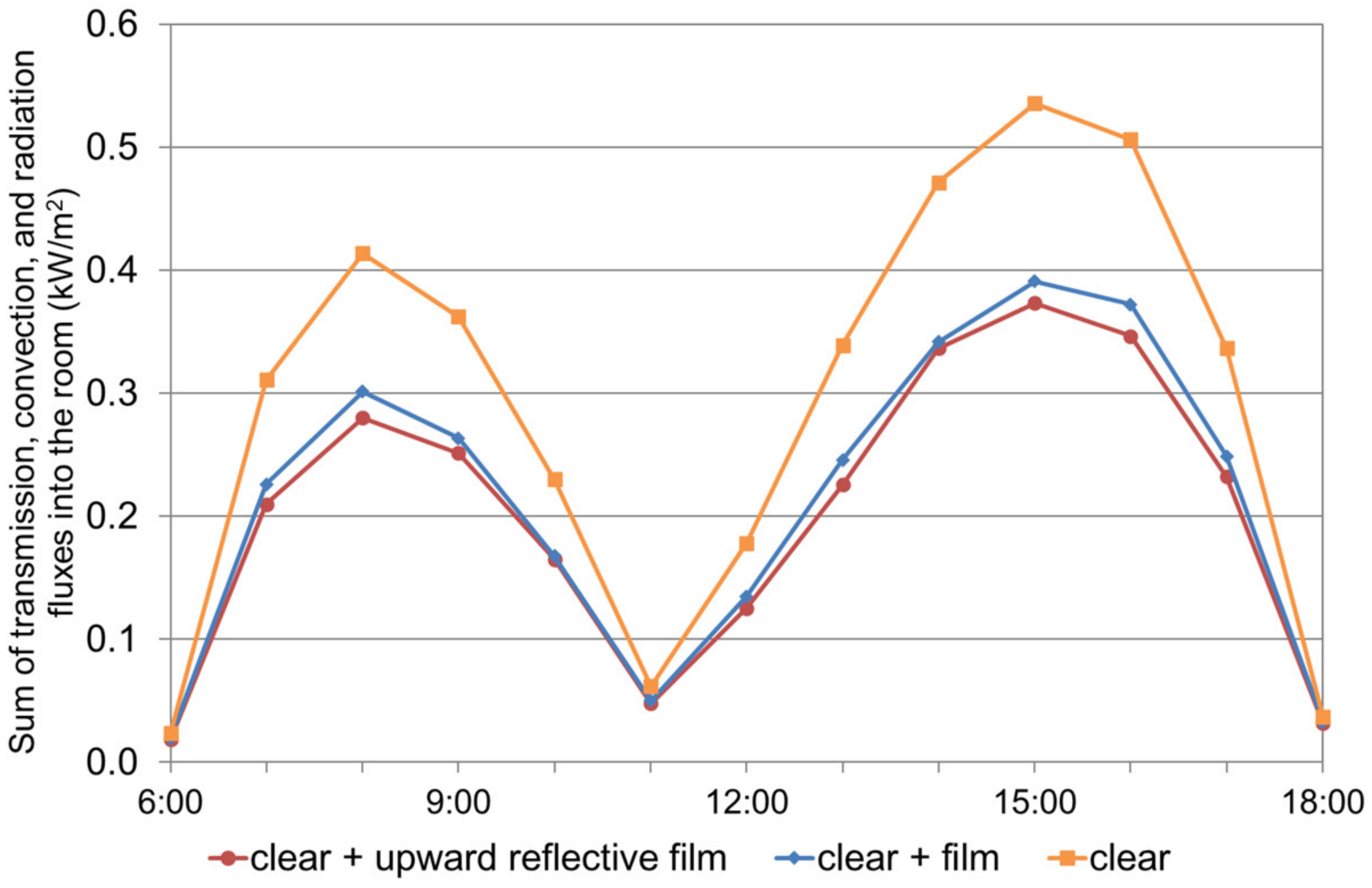
| Measurement Item | Measuring Equipment | Measurement Method |
|---|---|---|
| Atmospheric temperature | ESPEC Corporation Thermo Recorder RS–14 thermistor | Intervals: 1 min Accuracy: Average ± 0.5 °C (0–55 °C) |
| Humidity | ESPEC Corporation Thermo Recorder RS–14 Polymer film resistance type | Intervals: 1 min Accuracy: ±5%RH (25 °C 50%RH) |
| Globe temperature | EIKO INSTRUMENTS Globe sphere Diameter 15 cm ESPEC Corporation Thermo Recorder RT–32S thermistor | Intervals: 1 min (8:00 to 17:00) Accuracy: Average ± 0.3 °C (−20 to 80 °C) |
| Surface temperature | Thermo Recorder RT–32S thermistor | Accuracy: Average ± 0.3 °C (−20 to 80 °C) |
| Intensity of solar radiation | Tsuruga Electric Corporation LP PYRA03 | Intervals: 5 s (8:00 to 17:00) Range: 0–2000 W/m2 |
| Wind velocity | KANOMAX Anemo master MODEL6034 | Average of 30 instantaneous values Accuracy:±(3% of the indicated value + 0.1) m/s |
| Wind direction | Self-made streamers | The most frequent direction during the measurement of wind speed. |
| Thermal image | FLIR Systems FLIR ONE | Photograph the window to be measured (for checking surface temperature) |
| Vertical Incidence (Solar Altitude) Angle [°] | Retroreflective Film (Upward Reflective Film) | Film | Clear | |||||||||
|---|---|---|---|---|---|---|---|---|---|---|---|---|
| ρup | ρdown | τ | α | ρup | ρdown | τ | α | ρup | ρdown | τ | α | |
| 0 | 0.13 | 0.03 | 0.46 | 0.39 | 0.00 | 0.19 | 0.55 | 0.26 | 0.00 | 0.08 | 0.86 | 0.06 |
| 10 | 0.09 | 0.06 | 0.45 | 0.40 | 0.00 | 0.19 | 0.55 | 0.26 | 0.00 | 0.08 | 0.86 | 0.06 |
| 20 | 0.08 | 0.06 | 0.45 | 0.41 | 0.00 | 0.20 | 0.55 | 0.26 | 0.00 | 0.08 | 0.86 | 0.06 |
| 30 | 0.07 | 0.06 | 0.44 | 0.42 | 0.00 | 0.20 | 0.54 | 0.26 | 0.00 | 0.08 | 0.85 | 0.07 |
| 40 | 0.07 | 0.07 | 0.44 | 0.43 | 0.00 | 0.21 | 0.53 | 0.26 | 0.00 | 0.08 | 0.83 | 0.09 |
| 50 | 0.05 | 0.09 | 0.45 | 0.41 | 0.00 | 0.23 | 0.51 | 0.26 | 0.00 | 0.09 | 0.82 | 0.09 |
| 60 | 0.15 | 0.12 | 0.41 | 0.33 | 0.00 | 0.26 | 0.49 | 0.25 | 0.00 | 0.11 | 0.79 | 0.10 |
| 70 | 0.15 | 0.21 | 0.34 | 0.31 | 0.00 | 0.34 | 0.43 | 0.24 | 0.00 | 0.18 | 0.70 | 0.12 |
| 80 | 0.11 | 0.41 | 0.21 | 0.27 | 0.00 | 0.61 | 0.24 | 0.15 | 0.00 | 0.30 | 0.53 | 0.17 |
| 90 | 0.00 | 1.00 | 0.00 | 0.00 | 0.00 | 1.00 | 0.00 | 0.00 | 0.00 | 1.00 | 0.00 | 0.00 |
Disclaimer/Publisher’s Note: The statements, opinions and data contained in all publications are solely those of the individual author(s) and contributor(s) and not of MDPI and/or the editor(s). MDPI and/or the editor(s) disclaim responsibility for any injury to people or property resulting from any ideas, methods, instructions or products referred to in the content. |
© 2023 by the authors. Licensee MDPI, Basel, Switzerland. This article is an open access article distributed under the terms and conditions of the Creative Commons Attribution (CC BY) license (https://creativecommons.org/licenses/by/4.0/).
Share and Cite
Kyogoku, S.; Takebayashi, H. Effects of Upward Reflective Film Applied to Window Glass on Indoor and Outdoor Thermal Environments in a Mid-Latitude City. Sustainability 2023, 15, 3848. https://doi.org/10.3390/su15043848
Kyogoku S, Takebayashi H. Effects of Upward Reflective Film Applied to Window Glass on Indoor and Outdoor Thermal Environments in a Mid-Latitude City. Sustainability. 2023; 15(4):3848. https://doi.org/10.3390/su15043848
Chicago/Turabian StyleKyogoku, Sae, and Hideki Takebayashi. 2023. "Effects of Upward Reflective Film Applied to Window Glass on Indoor and Outdoor Thermal Environments in a Mid-Latitude City" Sustainability 15, no. 4: 3848. https://doi.org/10.3390/su15043848
APA StyleKyogoku, S., & Takebayashi, H. (2023). Effects of Upward Reflective Film Applied to Window Glass on Indoor and Outdoor Thermal Environments in a Mid-Latitude City. Sustainability, 15(4), 3848. https://doi.org/10.3390/su15043848










